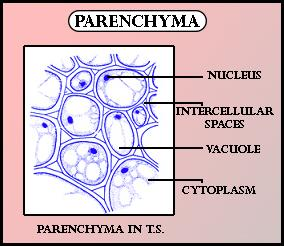
Write a note on Parenchyma.
Answer
579.3k+ views
Hint: Permanent tissues are the tissues which have lost the power to divide. The cellular tissue, typically soft and succulent, found chiefly in the softer parts of leaves, the pulp of fruits, bark and pith of stems, etc. It is a living tissue.
Complete answer:
Parenchyma is round or oval-shaped cells having spaces between them and they are Simple tissues are tissues composed of cells that are structurally and functionally similar i.e. they are made up of some type of cells. It is present in the stem, leaves, flowers, fruits and seeds. Most of them contain leucoplast and store food. Chloroplast containing parenchyma is named as chlorenchyma and affects photosynthesis. Parenchyma with large air spaces is named aerenchyma and is found in aquatic plants. Plant parenchyma cells will make the bulk of leaves, flowers, and the growing, dividing inner parts of stems and roots. They perform functions such as photosynthesis, food storage, sap secretion, and gas exchange.
Types of parenchyma:
There are four sorts of parenchyma consistent with their function:
-Photosynthetic parenchyma of camellia leaf.
-Storage parenchyma of the buttercup root cortex.
-Aquiferous parenchyma of a cactus.
-Aeriferous parenchyma of a rush stem.

Note: The parenchyma cells are found in many places throughout plant bodies and, as long as they're alive, are actively involved in photosynthesis, secretion, food storage, and other activities of flowers. Parenchyma is one of the three main kinds of ground, or fundamental, tissue in plants, in conjunction with sclerenchyma (dead support tissues with thick walls) and collenchyma (living support tissues with irregular walls).
Complete answer:
Parenchyma is round or oval-shaped cells having spaces between them and they are Simple tissues are tissues composed of cells that are structurally and functionally similar i.e. they are made up of some type of cells. It is present in the stem, leaves, flowers, fruits and seeds. Most of them contain leucoplast and store food. Chloroplast containing parenchyma is named as chlorenchyma and affects photosynthesis. Parenchyma with large air spaces is named aerenchyma and is found in aquatic plants. Plant parenchyma cells will make the bulk of leaves, flowers, and the growing, dividing inner parts of stems and roots. They perform functions such as photosynthesis, food storage, sap secretion, and gas exchange.
Types of parenchyma:
There are four sorts of parenchyma consistent with their function:
-Photosynthetic parenchyma of camellia leaf.
-Storage parenchyma of the buttercup root cortex.
-Aquiferous parenchyma of a cactus.
-Aeriferous parenchyma of a rush stem.

Note: The parenchyma cells are found in many places throughout plant bodies and, as long as they're alive, are actively involved in photosynthesis, secretion, food storage, and other activities of flowers. Parenchyma is one of the three main kinds of ground, or fundamental, tissue in plants, in conjunction with sclerenchyma (dead support tissues with thick walls) and collenchyma (living support tissues with irregular walls).
Recently Updated Pages
Why are manures considered better than fertilizers class 11 biology CBSE

Find the coordinates of the midpoint of the line segment class 11 maths CBSE

Distinguish between static friction limiting friction class 11 physics CBSE

The Chairman of the constituent Assembly was A Jawaharlal class 11 social science CBSE

The first National Commission on Labour NCL submitted class 11 social science CBSE

Number of all subshell of n + l 7 is A 4 B 5 C 6 D class 11 chemistry CBSE

Trending doubts
Differentiate between an exothermic and an endothermic class 11 chemistry CBSE

10 examples of friction in our daily life

One Metric ton is equal to kg A 10000 B 1000 C 100 class 11 physics CBSE

Difference Between Prokaryotic Cells and Eukaryotic Cells

1 Quintal is equal to a 110 kg b 10 kg c 100kg d 1000 class 11 physics CBSE

State the laws of reflection of light




